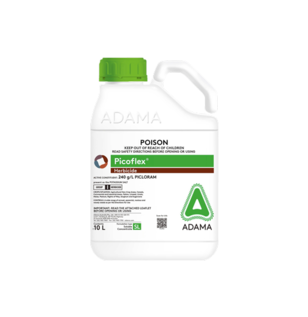
Northern croppers embrace new post-emergent weed control strategy

Chickpeas pictured in the untreated area of the Grindstone herbicide trial
The launch of Grindstone® by ADAMA Australia last season introduced a solo formulation of aminopyralid, which previously has only been available in co-formulations with other herbicides.
Jim O’Connor, Market Development Manager with ADAMA Australia in Southern Queensland, said growers used Grindstone® to create their own post-emergent brews particularly with picloram and MCPA herbicides, and with metsulfuron or fluroxypyr herbicides also added to tank mixes in some cases.
“It allowed flexibility with their post-emergent tank mixes, they could avoid using metsulfuron when using the aminopyralid in Grindstone®, and they could dial the aminopyralid rate up or down to suit their situation,” Jim said.
He said many growers took the opportunity to use a higher-than-normal rate of aminopyralid in their tank mixes to improve in-crop weed control and achieve good residual control into fallows and through to the following season.
“They applied it in mixes at the early tillering stage of crops and looked to suppress weeds through to the next growing season.”
“The higher rate of aminopyralid makes the tank mixes better and gives that extra residual punch, resulting in less weeds and cleaner paddocks.
“These mixes were particularly good against sowthistle and fleabane.”
The ability to select the rate of aminopyralid and other herbicides in tank mixes also allows greater re-cropping flexibility.
Jim said the cost-effectiveness of using Grindstone® with a range of tank-mix partners was another major attraction for growers and they also used the mixes to target climbing buckwheat, wireweed and volunteer pulses, as well as prickly lettuce in southern areas.
Grindstone® is compatible with a broad range of grass and broadleaf herbicides and doesn’t compromise efficacy of commonly used selective grass herbicides in cereal crops.

Its unique soluble liquid formulation also is user-friendly and easier to handle than existing granular products.
“The release of Grindstone® last year was certainly well received and supported by growers. Its use exceeded our expectations and we are prepared for stronger interest in the coming season,” Jim said.
While predominantly used to assist post-emergent and residual control of broadleaf weeds in winter cereals last year, Grindstone® also enhances partner herbicide efficacy of woody weeds including African boxthorn, blackberry, lantana, sweet briar and wattle in fallows, grass pastures and non-crop situations, as well as cereals.
Jim said, again, the ability to adjust rates of metsulfuron and picloram herbicides with Grindstone® was a benefit for these situations, plus using it in tank mixes with herbicides containing triclopyr.
Adam Altmann, Agronomist with Pursehouse Rural at Gunnedah in Northern New South Wales, trialled Grindstone® last season via the AgLink Product Development Program. It was included in tank mixes against a range of broadleaf weeds in wheat grown on heavy black soils near Tambar Springs, and while Adam was impressed with its knockdown ability, he also was particularly excited about the residual control it offered for growers.
Grindstone® was mixed with different herbicide partners and compared with other standard broadleaf tank mixes applied at the Z25 crop growth stage, targeting black bindweed, wireweed and some sowthistle and fleabane.
Adam said sowthistle and fleabane were the main broadleaf “culprits” throughout the region and the additive control provided by tank mixes containing Grindstone® was a “step up” over the other herbicide mixes.
“It definitely improved the broadleaf control, however the residual control it offers into summer fallows for this region is a big winner and also the reason we are excited about it,” Adam said.
“Due to the amount of cotton grown in the area, in summer we can struggle to use herbicides like 2,4-D. As a result, the aim is to minimise the reliance on knockdown control of these weeds in summer fallows, and Grindstone® can help us achieve that.
“Growers can use a higher rate to improve the residual control and still have good plantback ability into a cereal crop or sorghum.”
He expected popular tank-mix partners with Grindstone® could include MCPA as well as Picoflex® in-crop and in conjunction with Palmero® herbicide for fallow residual.
For further information on using the herbicide tank-mix partner, Grindstone®, growers can contact their local ADAMA Australia representative or visit ADAMA.com.
Products in this article

Grindstone®

Picoflex®

